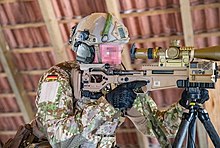Flecktarn
Flecktarn (German pronunciation: [ˈflɛktaʁn]; "mottled camouflage"; also known as Flecktarnmuster or Fleckentarn) is a family of three-, four-, five- or six-color disruptive camouflage patterns, the most common being the five-color pattern, consisting of dark green, grey-green, red brown, and black over a light green or tan base depending on the manufacturer.
A three-color variation called Tropentarn (formerly Wüstentarn) is intended for arid and desert conditions; the German Bundeswehr wore it in Afghanistan.
[2] In 1976, the Bundeswehr in Germany developed a number of prototype camouflage patterns, to be trialled as replacements for the solid olive-grey "moleskin" combat uniform.
Locally named "Stippel", the pattern met with media opposition for its perceived similarity to Waffen-SS "peas" and "oak leaves" camouflage.
)[7] Within the TL are material performance sheets for all products conforming to civilian, ISO, and military specifications, as applicable.
It is noteworthy here that the model developed in Germany was put into general use by the Belgian Air Force almost three years before it was introduced into the Bundeswehr.
A modular kit and a two-piece rucksack in flecktarn pattern was used to complete the uniform of field trousers, blouse and parka.
[13] The Russian military uses a wide range of different commercial camouflage patterns including several variations of flecktarn.
[citation needed] Another pattern resembling Bundeswehr five-color flecktarn has been used by some Russian forces with the difference being that the brown screen is red.
[18][19] The Samodzielny Pododdzial Antyterrorystyczny Policji - SPAP (anti-terrorism unit of the Polish National Police) have used a five-color flecktarn variant called WZ AT 1 Plamiak, also known as Metro colloquially.
[21] A woodland version referred to as Gepard has been used by the Agencja Bezpieczenstwa Wewnetrznego - ABW (Polish Internal Security Agency.
[23] In June 2022, Indonesia's Detasemen Khusus 88 Antiteror - DENSUS 88 AT (Police Counter-Terrorism Force) were seen wearing a flecktarn-influenced six-color camouflage uniform consisting of a tan base with three shades of green along with chocolate brown and near-black.
[25] The Special Security Forces of Yemen adopted a five-color digitalized pattern which could be said to resemble flecktarn but with darker colours similar to the pre-2005 colorway.





